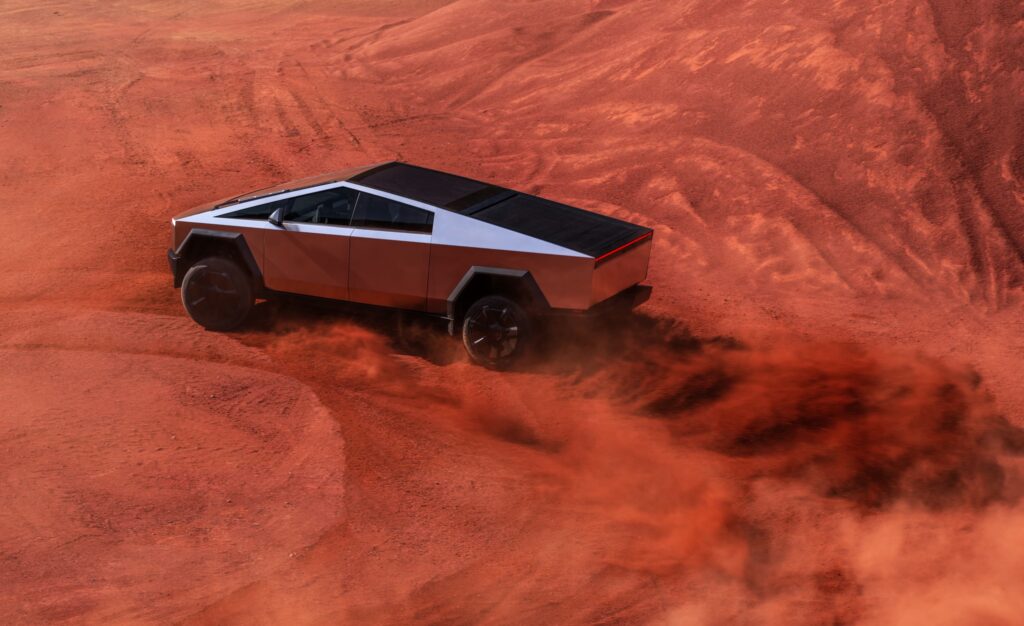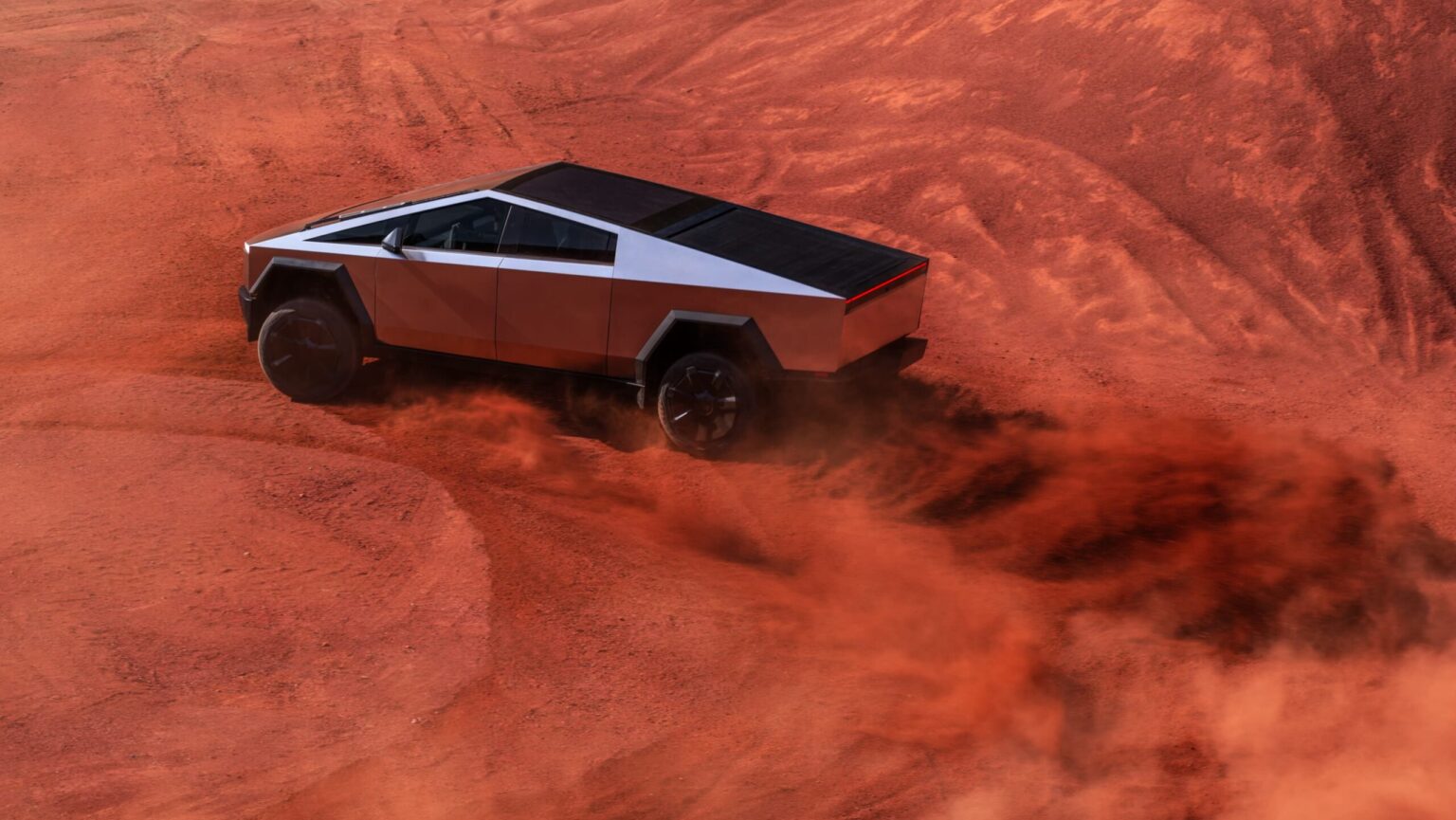Tesla Rolls Out Cybertruck in Saudi Arabia, Igniting EV Race in Middle East
Tesla has officially entered the Saudi Arabian market with the much-anticipated launch of its bold and futuristic Cybertruck, along with a refreshed Model Y. The grand unveiling took place at the scenic Bujairi Terrace in Riyadh, attracting industry leaders, local officials, tech enthusiasts, and prospective customers. This highly publicized event was more than just the launch of a new car—it signified Tesla’s commitment to supporting Saudi Arabia’s Vision 2030, a national strategy aimed at transforming the kingdom’s economy and promoting sustainable energy solutions.
In a remarkable turn of events, the launch was designed to highlight the company’s ability to tailor its product to the region’s unique cultural and geographical context. The desert-themed event featured an exciting demonstration, with the Cybertruck performing test drives on a sand-dune-styled track that mimicked the rough terrain typical of the Kingdom. The performance of the vehicle through such challenging conditions helped underscore Tesla’s commitment to meeting the demands of a market that values durability and rugged performance in its vehicles.
A Bold Step into the Gulf
Saudi Arabia’s push to become a key player in the global electric vehicle (EV) industry is no secret. Although electric vehicles currently make up only about 1% of cars on Saudi roads, the government has set an ambitious target to increase this figure to 30% by 2030. Tesla’s entry into the kingdom is seen as a significant step toward realizing this target. The government has been actively promoting clean energy technologies as part of its efforts to diversify the nation’s economy, which has long been dependent on oil.

During the launch event, a representative from the Ministry of Investment emphasized that Tesla’s arrival aligns perfectly with Saudi Arabia’s Vision 2030 objectives. “Tesla is not just bringing cars to the region; it’s bringing a vision of the future. This is part of our effort to build a cleaner, high-tech future for Saudi Arabia,” said the representative.
The arrival of Tesla also brings with it a host of service centers, retail outlets, and an ambitious plan to develop an extensive network of Supercharger stations across major cities like Riyadh, Jeddah, and Dammam. Given the vast distances between cities, especially in the desert regions, Tesla is also introducing mobile service units that will bring maintenance and support directly to customers in rural and less accessible areas. This approach is expected to significantly enhance Tesla’s customer service experience, making it easier for Saudi customers to maintain their vehicles.
From Feud to Friendship: Musk and the Kingdom Reconnect
One of the more significant elements of Tesla’s Saudi Arabian entry is the resolution of past tensions between Elon Musk and the Saudi government. The two parties were embroiled in a controversy back in 2018, when Musk claimed he had secured funding from Saudi Arabia’s Public Investment Fund (PIF) to take Tesla private. The statement was widely criticized, and it led to legal challenges that soured relations between Tesla and the Kingdom for some time.
However, it seems that both parties have put the past behind them, signaling a new chapter of cooperation. Over the last few years, Elon Musk has attended several international investment forums in Saudi Arabia, including the influential Future Investment Initiative (FII), where he interacted with key government officials. These engagements have paved the way for a renewed focus on innovation and collaboration, particularly in the fields of technology and sustainable energy.
“We’re in a much better place today,” said an anonymous source close to the project. “The past is behind us, and the focus now is on collaboration, technological leadership, and building a cleaner future.”
Tackling Infrastructure Gaps
Although the excitement surrounding Tesla’s launch is undeniable, the country faces significant challenges in terms of charging infrastructure. For instance, the 900-kilometer stretch between Riyadh and Mecca has only a limited number of fast-charging stations, which could deter long-distance EV travel.
To address this issue, Tesla plans to establish Supercharger stations along major highways and in urban areas. Additionally, the company is in talks with local developers to integrate charging stations into high-traffic areas such as shopping malls, office complexes, and hotel chains. This will help improve the overall convenience of owning a Tesla in Saudi Arabia.
On the government side, there is a national EV infrastructure development plan aimed at installing thousands of charging stations across the country in the coming years. Analysts predict that the public-private collaboration between Tesla and the Saudi government will be instrumental in driving EV adoption in the region. By working together, both parties hope to overcome the logistical barriers that currently limit the growth of the EV market.
What’s on Offer: Cybertruck and More
Tesla’s product offerings in Saudi Arabia include three key models:
- Model 3 – Tesla’s entry-level sedan, which remains a popular choice among eco-conscious buyers due to its affordability and long-range capabilities.
- Model Y – A newly redesigned compact SUV that is expected to capture the interests of families looking for a blend of utility, technology, and sustainability.
- Cybertruck – Tesla’s flagship vehicle, which made a significant splash during the launch event. The Cybertruck is expected to become a major player in Saudi Arabia’s luxury SUV and off-road vehicle market.
The Cybertruck is available in two main variants:
- Cybertruck SR 2024
- Price: SAR 307,088 (~$81,890)
- Features: Rear-wheel drive, 402 km range, with a design that offers a distinct Cyberpunk aesthetic.
- Cybertruck LR 2024
- Price: SAR 382,425 (~$101,980)
- Features: All-wheel drive, longer range, and superior off-road handling, making it an ideal option for the desert landscapes of Saudi Arabia.
The Cybertruck’s bold, angular design has generated a great deal of excitement in the region, with many attendees expressing awe at its performance in the simulated desert test drives. The truck’s off-road capabilities are expected to appeal to Saudi customers, many of whom value rugged vehicles suited for outdoor adventures.
“I never imagined a vehicle could look like this and feel so smooth to drive on sand,” said Faisal Al-Mutairi, a Riyadh-based entrepreneur and early Tesla adopter. His comment echoes the enthusiasm of many who participated in the launch event.
Facing Competition, But Standing Strong
Tesla is entering a highly competitive market, where it faces challenges from established brands and rising local competitors. Among the key players are:
- Lucid Motors, which is building a manufacturing facility in King Abdullah Economic City, supported by Saudi Arabia’s sovereign wealth fund, the Public Investment Fund (PIF).
- BYD and Zeekr, two Chinese EV manufacturers, which are ramping up operations in the Gulf and are expected to bring a range of competitively priced electric vehicles to the market.
- Several local EV startups that are benefiting from the kingdom’s push to support homegrown tech companies under the Vision 2030 framework.
However, despite this competition, Tesla has a clear advantage due to its strong brand recognition, innovative autonomous driving technology, and sophisticated software ecosystem. Additionally, the company’s plans to create local R&D and manufacturing capabilities could help establish it as a long-term leader in the region’s electric vehicle market.
What’s Next for Tesla and Saudi Arabia?
Looking to the future, Tesla’s expansion into Saudi Arabia is just the beginning. The company is reportedly exploring opportunities in the fields of solar energy, battery storage, and artificial intelligence (AI), all of which align with the kingdom’s broader goals of achieving energy independence and fostering green technology.
The Saudi market presents a strong growth opportunity for Tesla. The kingdom’s young population, high smartphone usage, and rising environmental awareness make it an ideal market for EV adoption. The next decade could see Tesla solidify its position as the leader of the region’s green energy revolution.
Conclusion
The Cybertruck launch in Saudi Arabia is a pivotal moment for both Tesla and the kingdom. The event is not just a product release; it marks a turning point in the country’s transition to a greener, more sustainable future. By entering the Saudi market, Tesla is not only capitalizing on the region’s growing interest in electric vehicles, but also supporting the kingdom’s wider efforts to diversify its economy and invest in cutting-edge technology.
With innovation, collaboration, and a shared vision of a cleaner future, the road to tomorrow is electric—and it runs straight through Riyadh.
Do follow gulf magazine on Instagram
for more information click here



